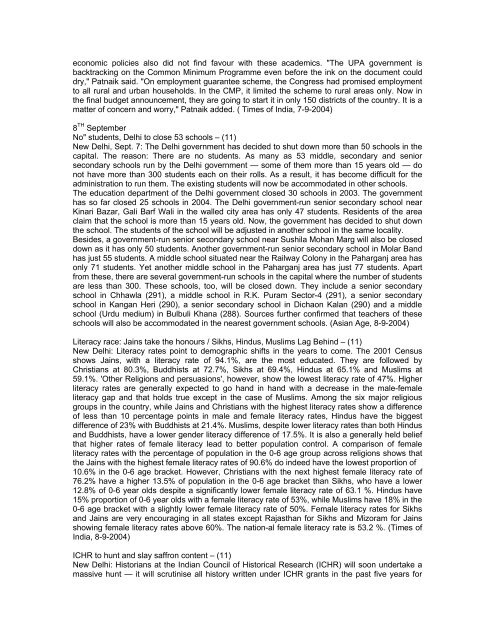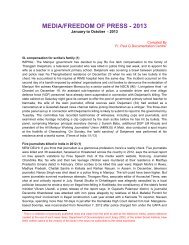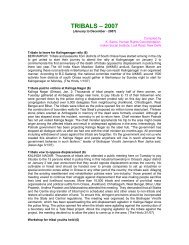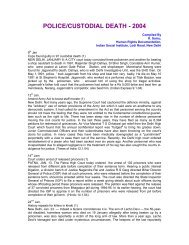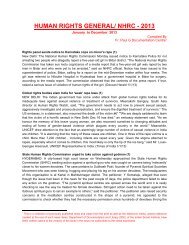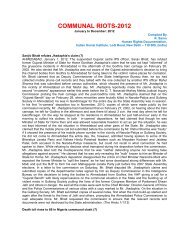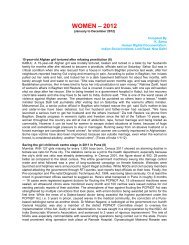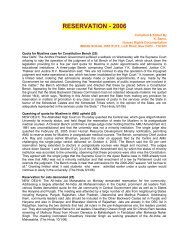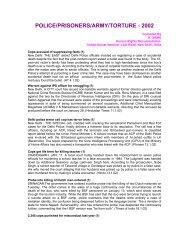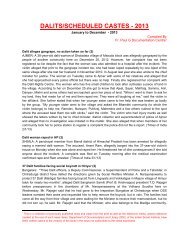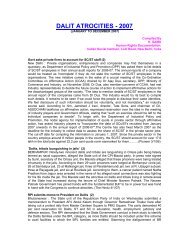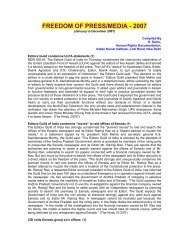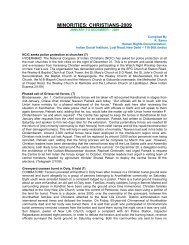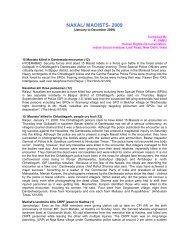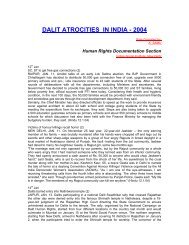EDUCATION - 2004 - Indian Social Institute
EDUCATION - 2004 - Indian Social Institute
EDUCATION - 2004 - Indian Social Institute
You also want an ePaper? Increase the reach of your titles
YUMPU automatically turns print PDFs into web optimized ePapers that Google loves.
economic policies also did not find favour with these academics. "The UPA government is<br />
backtracking on the Common Minimum Programme even before the ink on the document could<br />
dry," Patnaik said. "On employment guarantee scheme, the Congress had promised employment<br />
to all rural and urban households. In the CMP, it limited the scheme to rural areas only. Now in<br />
the final budget announcement, they are going to start it in only 150 districts of the country. It is a<br />
matter of concern and worry," Patnaik added. ( Times of India, 7-9-<strong>2004</strong>)<br />
8 TH September<br />
No" students, Delhi to close 53 schools – (11)<br />
New Delhi, Sept. 7: The Delhi government has decided to shut down more than 50 schools in the<br />
capital. The reason: There are no students. As many as 53 middle, secondary and senior<br />
secondary schools run by the Delhi government — some of them more than 15 years old — do<br />
not have more than 300 students each on their rolls. As a result, it has become difficult for the<br />
administration to run them. The existing students will now be accommodated in other schools.<br />
The education department of the Delhi government closed 30 schools in 2003. The government<br />
has so far closed 25 schools in <strong>2004</strong>. The Delhi government-run senior secondary school near<br />
Kinari Bazar, Gali Barf Wali in the walled city area has only 47 students. Residents of the area<br />
claim that the school is more than 15 years old. Now, the government has decided to shut down<br />
the school. The students of the school will be adjusted in another school in the same locality.<br />
Besides, a government-run senior secondary school near Sushila Mohan Marg will also be closed<br />
down as it has only 50 students. Another government-run senior secondary school in Molar Band<br />
has just 55 students. A middle school situated near the Railway Colony in the Paharganj area has<br />
only 71 students. Yet another middle school in the Paharganj area has just 77 students. Apart<br />
from these, there are several government-run schools in the capital where the number of students<br />
are less than 300. These schools, too, will be closed down. They include a senior secondary<br />
school in Chhawla (291), a middle school in R.K. Puram Sector-4 (291), a senior secondary<br />
school in Kangan Heri (290), a senior secondary school in Dichaon Kalan (290) and a middle<br />
school (Urdu medium) in Bulbuli Khana (288). Sources further confirmed that teachers of these<br />
schools will also be accommodated in the nearest government schools. (Asian Age, 8-9-<strong>2004</strong>)<br />
Literacy race: Jains take the honours / Sikhs, Hindus, Muslims Lag Behind – (11)<br />
New Delhi: Literacy rates point to demographic shifts in the years to come. The 2001 Census<br />
shows Jains, with a literacy rate of 94.1%, are the most educated. They are followed by<br />
Christians at 80.3%, Buddhists at 72.7%, Sikhs at 69.4%, Hindus at 65.1% and Muslims at<br />
59.1%. 'Other Religions and persuasions', however, show the lowest literacy rate of 47%. Higher<br />
literacy rates are generally expected to go hand in hand with a decrease in the male-female<br />
literacy gap and that holds true except in the case of Muslims. Among the six major religious<br />
groups in the country, while Jains and Christians with the highest literacy rates show a difference<br />
of less than 10 percentage points in male and female literacy rates, Hindus have the biggest<br />
difference of 23% with Buddhists at 21.4%. Muslims, despite lower literacy rates than both Hindus<br />
and Buddhists, have a lower gender literacy difference of 17.5%. It is also a generally held belief<br />
that higher rates of female literacy lead to better population control. A comparison of female<br />
literacy rates with the percentage of population in the 0-6 age group across religions shows that<br />
the Jains with the highest female literacy rates of 90.6% do indeed have the lowest proportion of<br />
10.6% in the 0-6 age bracket. However, Christians with the next highest female literacy rate of<br />
76.2% have a higher 13.5% of population in the 0-6 age bracket than Sikhs, who have a lower<br />
12.8% of 0-6 year olds despite a significantly lower female literacy rate of 63.1 %. Hindus have<br />
15% proportion of 0-6 year olds with a female literacy rate of 53%, while Muslims have 18% in the<br />
0-6 age bracket with a slightly lower female literacy rate of 50%. Female literacy rates for Sikhs<br />
and Jains are very encouraging in all states except Rajasthan for Sikhs and Mizoram for Jains<br />
showing female literacy rates above 60%. The nation-al female literacy rate is 53.2 %. (Times of<br />
India, 8-9-<strong>2004</strong>)<br />
ICHR to hunt and slay saffron content – (11)<br />
New Delhi: Historians at the <strong>Indian</strong> Council of Historical Research (ICHR) will soon undertake a<br />
massive hunt — it will scrutinise all history written under ICHR grants in the past five years for


